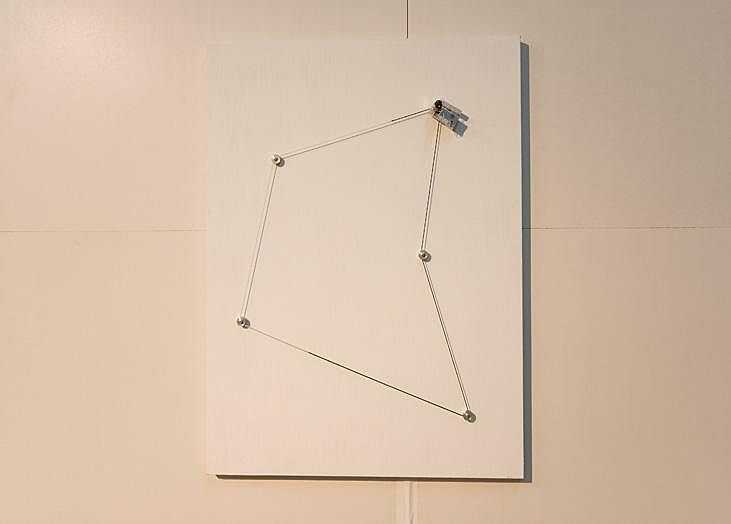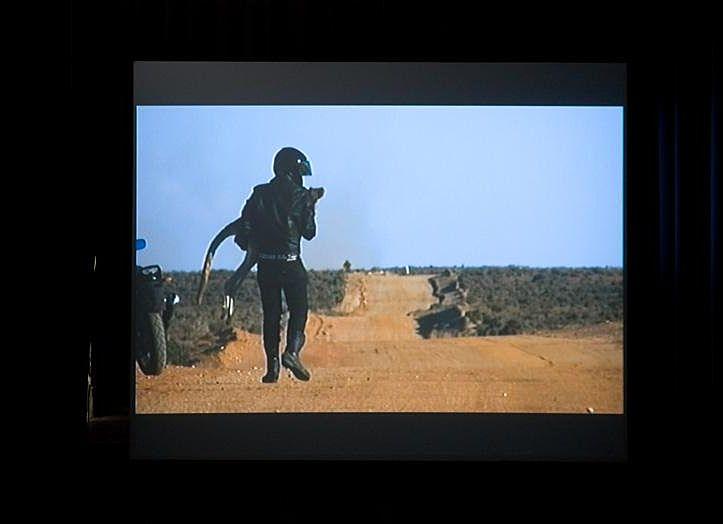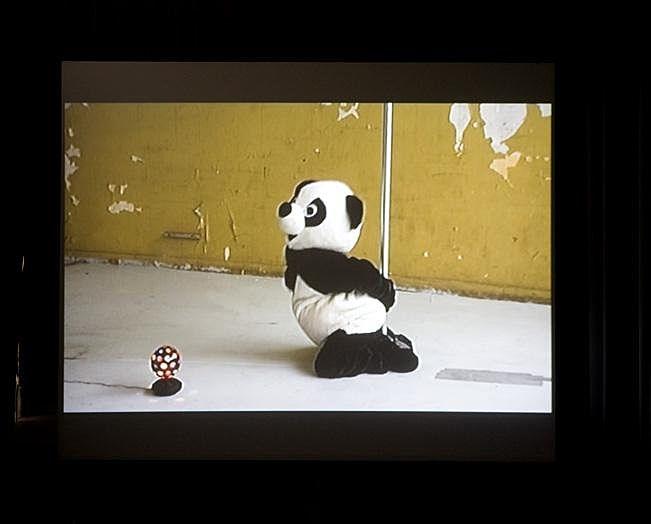Liste 08
2.6. —
8.6.2008
Kunsthaus Baselland is proud to have been chosen as a guest institution to represent itself at LISTE 08 — the young art fair.
The particular space given to guest institutions serves as an all-year platform for print making, especially handcrafted and highly specialized prints. The heavy machinery — still very visible and immobile — together with the special patina of old prints glued to the wall, paint and dust accumulated over the years served as one conceptual starting point for the exhibition presented. The different marks of work traces characterize the space with a certain historical notion and its link to the present which made me explore artistic practices and ask how certain work periods impact the body of work more than others and are important in terms of an inherent conceptual development. Together with the artists I chose works that address a process-oriented questionnaire and react to the oddness of the space. Since Kunsthaus Baselland has been invited as an institution with an extraordinary track record and success over the last few years, I decided to work with artists who have already been represented by Kunsthaus Baselland before, with a view to giving back some of its success to the ones contributing to it. Of course, this special invitation demands selection and not all of the more than 300 artists we have worked with since 2001 could be featured. At this point I would like to point out our website which gives a great overview of all the exhibitions we did, providing image and text material in the archive section. Please visit: www.kunsthausbaselland.ch I would like to thank all the artists we have worked with over the years, their galleries, my colleagues with whom we were involved in collaborative projects and my team; thanks to them and their enthusiasm we have been able to carry out highly ambitious. My special thanks goes out to Peter Bläuer, who enabled this presentation as well as our main sponsor kulturelles.bl.

Anna Amadio focuses on the printing machines that can be found in the print shop, the venue of this exhibition and presentation. After her drawings, where she already pursued different approaches to the basics of frottage and the drawing materials, both of which she put to different uses, thus constantly creating new landscape sceneries, the artist now produces three-dimensional frottage for the first time: the impression of the machines produced by applying film shrinking techniques. The machines appear in new apparel, as it were, and mutate into independent, unknown forms. Their fleshy colour bestows upon them a faint human reference, which fades away again, however, given their shapes.

Thomas Baumann is renowned for his works constantly questioning the traditional concept of sculpture. In his edition designed specifically for Liste-the young art fair Baumann equips a rope with an engine turning it into a mobile drawing on the wall and thus also into a mural sculpture. His sculptures focus not only on motion and the relationship to the exhibition space and the viewer but also on changing forms and achieving a well-balanced composition. His concept of artistic work gives room to change and modification, smoothing the way for a characterisation of our contemporary society.

Stefan Burger is a photographer eager to get to the bottom of his medium, especially with regard to its conceptual potential. In doing so, he pursues a wide variety of approaches and does not recoil from using other media as well. For Two hidden light stands in a landscape he created a composition using objects he found and adding selected items to them. The driveway with its seemingly constructivist wall into which concrete cubes have been incorporated and whose plaster is reminiscent of the surface found in many a pizzeria becomes the venue for a staged happening where different objects, including two photo tripods, make a brief appearance. In this work created specifically for Liste-the young art fair Burger gives an account of photography itself, dealing also with the various steps and aesthetics of its production.

The second room of the print shop serving as venue for this presentation is dedicated to works from the realm of film and video. A mural installation by Philippe Decrauzat introduces the video programm In Komakino, the kinematic aspects of the dream machine (which is actually intended to evoke hypnotic states) are spread out on a wall. It follows a regular pattern of perforations. On the fields symbolising these perforations drawings have been put up which are a kind of signal: “Attention, this is where the film begins!” (Philippe Decrauzat)

Shaun Gladwell’s video Apology to Roadkill belongs to the trilogy Maddest Maximus. All three videos depict a movement, seemingly endless and directionless, through the vastness of the Australian landscape. In Apology to Roadkill the artist gets off his motorbike to approach one of the dead kangaroos that perish on the roads every day and are simply left lying around. In a reminiscence of rituals, the artist runs his hand over the dead animal before carrying it off the road. A note of melancholy underlies this work, making viewers think of an attempt to make amends for the fact that this country conquered by immigrants treats animals in a way that living beings do not deserve.

“Whatever kind of assault you can make on film material, I’ve done it.” This is how Amy Granat describes her approach to taking the potential offered by films as a medium to new levels. Films from estates or flea markets are her source material, which she modifies by means of punching holes, acid etching, cutting, mirroring, superposing, scratching, etc. Her interventions, which usually seem destructive in nature, give rise to a new kind of sensuality. The distortions, discontinuities and rhythmic transformations, combined with the deliberate use of music that goes with them most of the time, create new forms which are particularly reminiscent of painting.

Gestures and the influence of chance provide the basis for Renée Levi’s sprayed paintings. For each of her paintings, the artist establishes a set of conceptual parameters such as spraying distance, spraying density, colour, pre-defined layout of lines, etc. to which she subsequently adheres in the course of one or more painting sessions. When the spraying can runs out of colour, the line comes to an end. It may have a new beginning or take on a different form. Levi’s works constantly question the nature of painting and its relationship to the places where it is shown, and are open to experimental and discursive approaches.

In her video, Je suis une bombe, Elodie Pong deals with a fundamental change in the perception of the cultural image of women, which has always been regarded as something exceptional. At the beginning of the video, a woman wearing a panda costume approaches a dancing pole and starts dancing around it with movements that are unmistakeably sexually charged. The music and dancing promise the fulfilment of sexual expectations. If the panda costume — making sexually seductive movements appear awkward and funny — did not exist, everything would be clear. Having finished dancing, the dancer takes off the head of the panda costume, takes a breather and runs towards the camera looking directly into it, assuring the viewers that she is not only a sex bomb but also sublime and perfect. The notion of women selling their bodies and offering their services to men — traditionally a bête noire from a feminist point of view — is being reinterpreted in this work.

As is already indicated by its name, Markus Schwander’s latest series of works, Capriccios, consists of a number of miniature sculptures marked by sensual irony and capriciousness. Plaster casts of vases, fruits and small every-day items mix with real objects. No matter whether they are reduced to the white non-colour or colour sprayed, the miniature sculptures play constantly with the imagination of the viewers. They depict not only detached moments of human communication, when people feel satiated and start putting one thing over and into another, but also historical still lifes characterised by seriousness. The relationship between pedestal and sculpture, a topic of central importance to art history dealing with the question of being and bearing a burden (i.e. hierarchies) is turned into a playfully ironic commentary in Schwander’s Capriccios.

Gavin Turk’s Apple Cores made of cast bronze is the immediate representation of an apple that has been eaten away. It can be seen not only as a form of immortal ‘social sculpture’ — ‘produced’ by each and every one of us — but also as a three-dimensional still life with all its historical references. Usually, the remains of the apple that has been consumed can be found in waste bins or on the fringes of human paths. They are relics of human waste and form part of the eternal process of creation and decay.

For Liste-the young art fair Martin Walde created a special edition of drawings on tissue paper, rolled-up and ready to be cut off individually. Each sheet of paper depicts a Madonna holding a Buddha-like baby in her hand. The drawings may be cut off, one by one, and framed or simply be crumpled up turning them into a three dimensional paper sculpture. The artist leaves room for processes of reception and the future owner is free to decide whether he would like to buy a drawing or a sculpture.